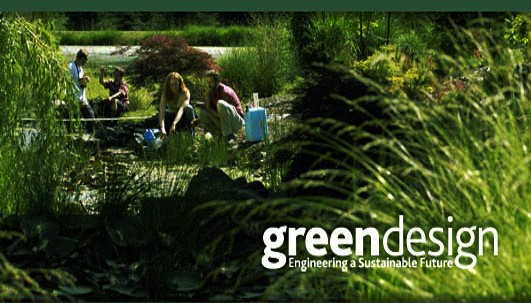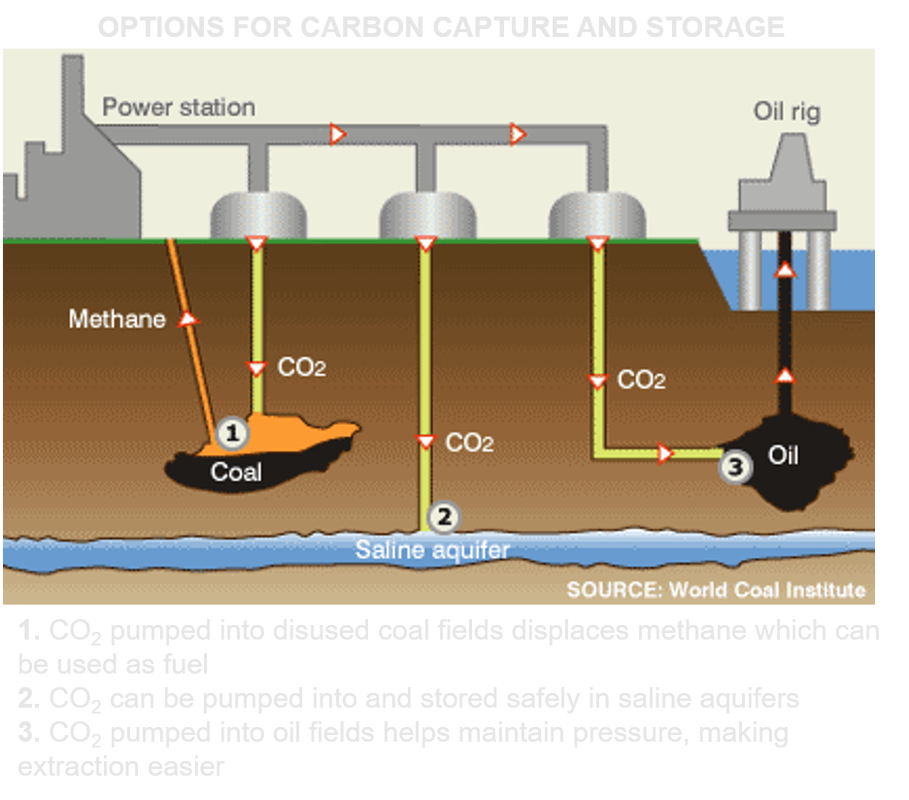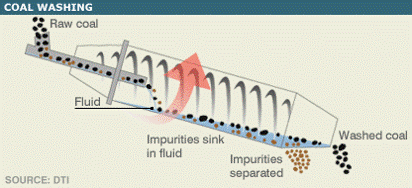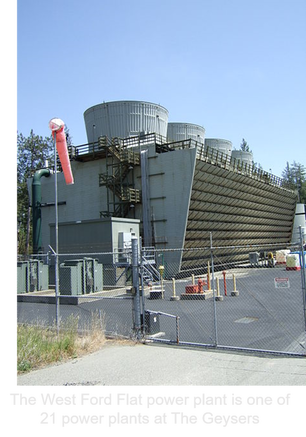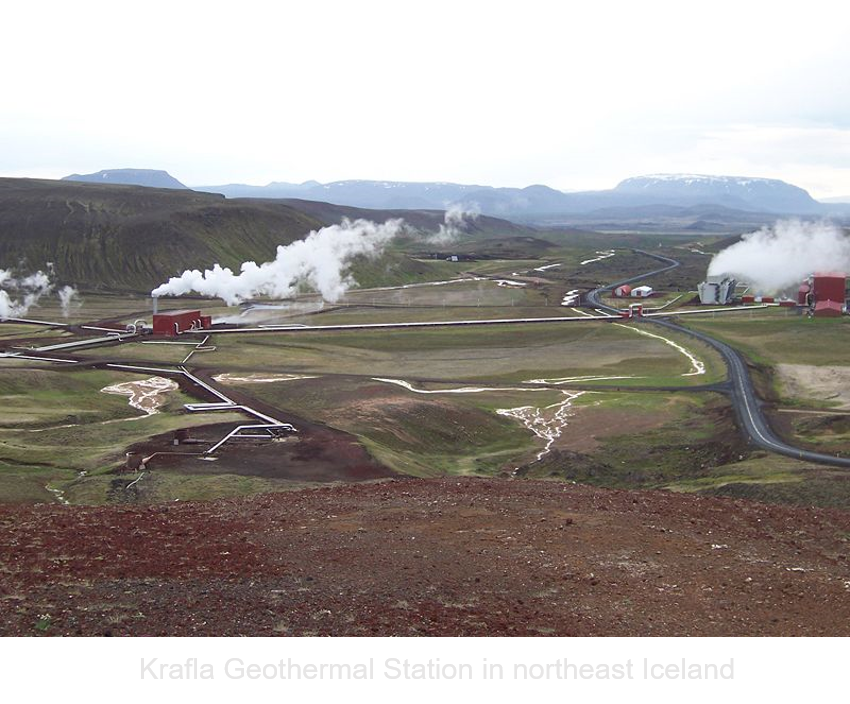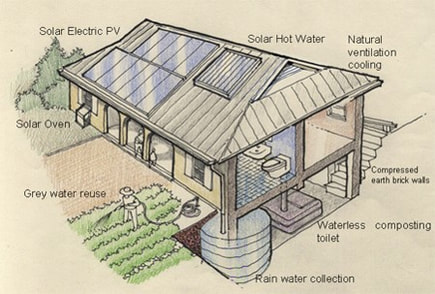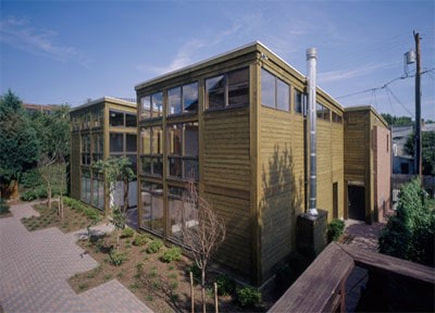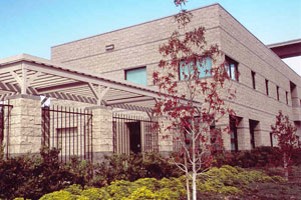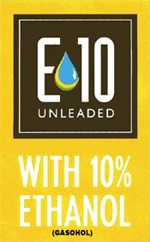2.1
Green design: Designing in a way that takes account of the environmental impact of the product throughout its life.
Renewable resources: Resources that are naturally replenished in a short time
”A natural resource qualifies as a renewable resource if it is replenished by natural processes at a rate almost the same as its rate of consumption by humans or other users”.
”A natural resource qualifies as a renewable resource if it is replenished by natural processes at a rate almost the same as its rate of consumption by humans or other users”.
Non-renewable resources: A natural resource that cannot be re-made or re-grown as it does not naturally re-form at a rate that makes its use sustainable, for example, coal, petroleum and natural gas.
This term is refers to a resource that is inexhaustible therefore can be replenished quick enough. Hardwood trees (such as many rainforest species) take a fair bit of time to mature to a point where is is useable as a resource, therefore, it is considered non-renewable. On the other hand, softwoods (such as Pines or conifers) mature more quickly and are considered a renewable resource.
This term is refers to a resource that is inexhaustible therefore can be replenished quick enough. Hardwood trees (such as many rainforest species) take a fair bit of time to mature to a point where is is useable as a resource, therefore, it is considered non-renewable. On the other hand, softwoods (such as Pines or conifers) mature more quickly and are considered a renewable resource.
Sustainable design (also referred to as "green design", "eco-design", or "design for environment") is the art of designing physical objects and the built environment to comply with the principles of economic, social, and ecological sustainability. It ranges from the microcosm of designing small objects for everyday use, through to the macrocosm of designing buildings, cities, and the earth's physical surface. It is a growing trend within the fields of architecture, landscape architecture, engineering, graphic design, industrial design, interior design and fashion design.
The essential aim of sustainable design is to produce places, products and services in a way that reduces use of non-renewable resources, minimizes environmental impact, and relates people with the natural environment. Sustainable design is often viewed as a necessary tool for achieving sustainability. It is related to the more heavy-industry-focused fields of industrial ecology and green chemistry, sharing tools such as life cycle assessment and life cycle energy analysis to judge the environmental impact or "greenness" of various design choices
The essential aim of sustainable design is to produce places, products and services in a way that reduces use of non-renewable resources, minimizes environmental impact, and relates people with the natural environment. Sustainable design is often viewed as a necessary tool for achieving sustainability. It is related to the more heavy-industry-focused fields of industrial ecology and green chemistry, sharing tools such as life cycle assessment and life cycle energy analysis to judge the environmental impact or "greenness" of various design choices
|
Non-renewable or finite energy resources are sources of power that cannot be replaced once they are used, because the energy source has taken millions of years to form (eg coal, gas and oil). |
|
Some resources can be thought of as both renewable and non-renewable. Wood can be used for fuel and is renewable if trees are replanted. Biomass, which is material from living things, can be renewable if plants are replanted. |
Nuclear fuels
You should be able to outline how electricity is generated using nuclear fuels.
Uranium and plutonium
The main nuclear fuels are uranium and plutonium. These are radioactive metals. Nuclear fuels are not burnt to release energy. Instead, the fuels are involved in nuclear reactions in the nuclear reactor, which leads to heat being released.
The rest of the process of generating electricity is then identical to the process using fossil fuels
The heat energy is used to boil water. The kinetic energy in the expanding steam spins turbines, which then drive generators to produce electricity.
You should be able to outline how electricity is generated using nuclear fuels.
Uranium and plutonium
The main nuclear fuels are uranium and plutonium. These are radioactive metals. Nuclear fuels are not burnt to release energy. Instead, the fuels are involved in nuclear reactions in the nuclear reactor, which leads to heat being released.
The rest of the process of generating electricity is then identical to the process using fossil fuels
The heat energy is used to boil water. The kinetic energy in the expanding steam spins turbines, which then drive generators to produce electricity.
|
Advantages
Unlike fossil fuels, nuclear fuels do not produce carbon dioxide or sulphur dioxide. |
Disadvantages
Like fossil fuels, nuclear fuels are non-renewable energy resources. If there is an accident, large amounts of radioactive material could be released into the environment. In addition, nuclear waste remains radioactive and is hazardous to health for thousands of years. It must be stored safely. (GCSE bitesize) |
Clean coal technology
How it works:
When burned, coal is the dirtiest of all fossil fuels but a range of technologies are being used and developed to reduce the environmental impact of coal-fired power stations. Collectively, they are known as clean coal technology (CCT).
How it works:
When burned, coal is the dirtiest of all fossil fuels but a range of technologies are being used and developed to reduce the environmental impact of coal-fired power stations. Collectively, they are known as clean coal technology (CCT).
|
Carbon Capture and Connect
Despite the improving efficiency of coal-fired power stations, CO2 emissions remain a problem. Carbon capture and storage (CCS) involves capturing the carbon dioxide, preventing the greenhouse gas entering the atmosphere, and storing it deep underground. A range of approaches of CCS have been developed and have proved to be technically feasible. They have yet to be made available on a large-scale commercial basis because of the costs involved. |
|
Coal Preparation
Coal arriving at a power plant contains mineral content that needs to be removed before it is burnt. A number of processes are available to remove unwanted matter and make the coal burn more efficiently. Coal washing involves grinding the coal into smaller pieces and passing it through a process called gravity separation. One technique involves feeding the coal into barrels containing a fluid that has a density which causes the coal to float, while unwanted material sinks and is removed from the fuel mix. The coal is then pulverised and prepared for burning. |
|
|
|
Wind power is the conversion of wind energy into more useful forms, usually electricity, using wind turbines. At the end of 2006, worldwide capacity of wind-powered generators was 74,223 megawatts; although it currently produces just over 1% of world-wide electricity use, it accounts for approximately 20% of electricity use in Denmark, 9% in Spain, and 7% in Germany. Globally, wind power generation more than quadrupled between 2000 and 2006.
Most modern wind power is generated in the form of electricity by converting the rotation of turbine blades into electrical current by means of an electrical generator. In windmills (a much older technology), wind energy is used to turn mechanical machinery to do physical work, such as crushing grain or pumping water.
Most modern wind power is generated in the form of electricity by converting the rotation of turbine blades into electrical current by means of an electrical generator. In windmills (a much older technology), wind energy is used to turn mechanical machinery to do physical work, such as crushing grain or pumping water.
Wind power is used in large scale wind farms for national electrical grids as well as in small individual turbines for providing electricity to rural residences or grid-isolated locations.
Wind energy is plentiful, renewable, widely distributed, clean, and reduces toxic atmospheric and greenhouse gas emissions if used to replace fossil-fuel-derived electricity. The intermittency of wind seldom creates problems when using wind power at low to moderate penetration levels (though such intermittency has caused problems for grid stability in Denmark and Germany, where penetration is greatest).
Wind energy is plentiful, renewable, widely distributed, clean, and reduces toxic atmospheric and greenhouse gas emissions if used to replace fossil-fuel-derived electricity. The intermittency of wind seldom creates problems when using wind power at low to moderate penetration levels (though such intermittency has caused problems for grid stability in Denmark and Germany, where penetration is greatest).
|
Solar Power
Solar power (also known as solar energy) is a source of power that uses energy from the sun. The term solar energy is used more specifically to describe the utilization of this energy through human endeavor. It is a renewable energy source that has been used in many traditional technologies for centuries. It is also in widespread use where other power supplies are absent, such as in remote locations and in space. The primary forms of solar energy are heat and light. Secondary forms and effects include photosynthesis, wind, the Gulf Stream, the hydrologic cycle, fossil fuels and electricity. |
|
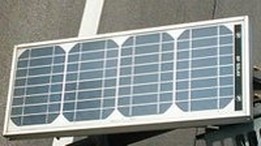
Photovoltaics
Solar cells, also referred to as photovoltaic cells, are devices or banks of devices that use the photovoltaic effect of semiconductors to generate electricity directly from sunlight. Until recently, their use has been limited because of high manufacturing costs. One cost effective use has been in very low-power devices such as calculators with LCDs. Another use has been in remote applications such as roadside emergency telephones, remote sensing, cathodic protection of pipe lines, and limited "off grid" home power applications. A third use has been in powering orbiting satellites and spacecraft.
Photovoltaic (PV) modules are composed of multiple PV cells. Two or more interconnected PV modules create an array.
Solar cells, also referred to as photovoltaic cells, are devices or banks of devices that use the photovoltaic effect of semiconductors to generate electricity directly from sunlight. Until recently, their use has been limited because of high manufacturing costs. One cost effective use has been in very low-power devices such as calculators with LCDs. Another use has been in remote applications such as roadside emergency telephones, remote sensing, cathodic protection of pipe lines, and limited "off grid" home power applications. A third use has been in powering orbiting satellites and spacecraft.
Photovoltaic (PV) modules are composed of multiple PV cells. Two or more interconnected PV modules create an array.
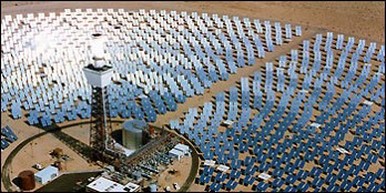
Solar Power Plants
Solar power plants use a variety of methods to collect sunlight and convert this energy into electricity, distill water or provide heat for industrial processes. Concentrating solar thermal power plants are the most common form of solar power plant.
Concentrating Solar Thermal (CST) systems use lenses or mirrors and tracking systems to focus a large area of sunlight into a small beam. CST technologies require direct insolation to perform properly. This requirement makes them inappropriate for significantly overcast locations.
The three basic CST technologies are the solar trough, solar power tower and parabolic dish. Each technology is capable of producing high temperatures and correspondingly high thermodynamic efficiencies but they vary in the way they track the sun and focus light Solar Two power tower surrounded by a field of heliostats.
Solar power plants use a variety of methods to collect sunlight and convert this energy into electricity, distill water or provide heat for industrial processes. Concentrating solar thermal power plants are the most common form of solar power plant.
Concentrating Solar Thermal (CST) systems use lenses or mirrors and tracking systems to focus a large area of sunlight into a small beam. CST technologies require direct insolation to perform properly. This requirement makes them inappropriate for significantly overcast locations.
The three basic CST technologies are the solar trough, solar power tower and parabolic dish. Each technology is capable of producing high temperatures and correspondingly high thermodynamic efficiencies but they vary in the way they track the sun and focus light Solar Two power tower surrounded by a field of heliostats.
|
|
Tidal Power
Tidal power sometimes called tidal energy, is a form of hydropower that exploits the rise and fall in sea levels due to the tides, or the movement of water caused by the tidal flow. Although not yet widely used, tidal power has potential for future electricity generation and is more predictable than wind energy and solar power. In Europe, tide mills have been used for over a thousand years, mainly for grinding grains. Tidal power can be classified into two types: Barages and tidal stream systems. |
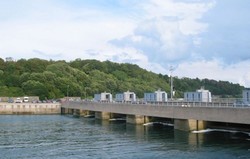
Barrages make use of the potential energy from the difference in height (or head) between high and low tides, and their use is better established. These suffer from the dual problems of very high civil infrastructure costs and environmental issues.
Barrages make use of the potential energy from the difference in height (or head) between high and low tides, and their use is better established. These suffer from the dual problems of very high civil infrastructure costs and environmental issues.

Tidal stream systems make use of the kinetic energy from the moving water currents to power turbines, in a similar way to underwater wave turbines. This method is gaining in popularity because of the lower cost and lower ecological impact.
|
Wave Power Waves are generated by the wind as it blows across the ocean surface. They travel great distances without significant losses and so act as an efficient energy transport mechanism across thousands of kilometres. The energy can be captured by various devices, which produce enough movement either of air or water to drive generators that converts the energy into electricity. |
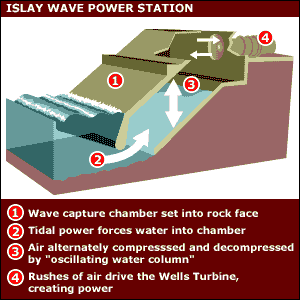
Oscillating water column
An oscillating water column is a partially submerged, hollow structure that is installed in the ocean. It is open to the sea below the water line, enclosing a column of air on top of a column of water. Waves cause the water column to rise and fall, which in turn compresses and depresses the air column. This trapped air is allowed to flow to and from the atmosphere via a Wells turbine, which has the ability to rotate in the same direction regardless of the direction of the airflow. The rotation of the turbine is used to generate electricity.
http://news.bbc.co.uk/2/hi/science/nature/1032148.stm
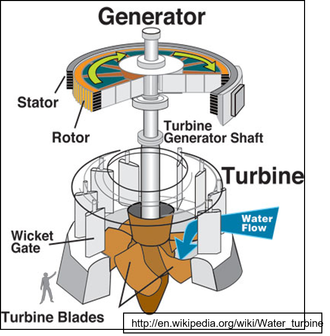
Hydroelectricity
Hydroelectricity is electricity produced by hydropower. Hydroelectricity now supplies about 715,000 MWe or 19% of world electricity (16% in 2003). It is also the world's leading form of renewable energy, accounting for over 63% of the total in 2005.
Although large hydroelectric installations generate most of the world's hydroelectricity, small hydro schemes are particularly popular in China, which has over 50% of world small hydro capacity.
Most hydroelectric power comes from the potential energy of dammed water driving a water turbine and generator. In this case the energy extracted from the water depends on the volume and on the difference in height between the source and the water's outflow. This height difference is called the head. The amount of potential energy in water is proportional to the head. To obtain very high head, water for a hydraulic turbine may be run through a large pipe called a penstock.
Hydroelectricity is electricity produced by hydropower. Hydroelectricity now supplies about 715,000 MWe or 19% of world electricity (16% in 2003). It is also the world's leading form of renewable energy, accounting for over 63% of the total in 2005.
Although large hydroelectric installations generate most of the world's hydroelectricity, small hydro schemes are particularly popular in China, which has over 50% of world small hydro capacity.
Most hydroelectric power comes from the potential energy of dammed water driving a water turbine and generator. In this case the energy extracted from the water depends on the volume and on the difference in height between the source and the water's outflow. This height difference is called the head. The amount of potential energy in water is proportional to the head. To obtain very high head, water for a hydraulic turbine may be run through a large pipe called a penstock.
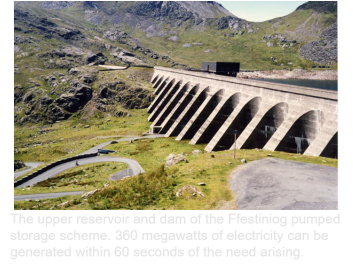
Pumped storage hydroelectricity produces electricity to supply high peak demands by moving water between reservoirs at different elevations. At times of low electrical demand, excess generation capacity is used to pump water into the higher reservoir. When there is higher demand, water is released back into the lower reservoir through a turbine. Pumped storage schemes currently provide the only commercially important means of grid energy storage and improve the daily load factor of the generation system.
Less common types of hydro schemes use water's kinetic energy or undammed sources such as run-of-the-river, waterwheels, and tidal power.
Less common types of hydro schemes use water's kinetic energy or undammed sources such as run-of-the-river, waterwheels, and tidal power.
|
|
|
|
|
|
|
|
|
|
Biomass Power
Biomass refers to energy produced by the combustion or gasification of organic material. It includes short - rotation coppice, forestry waste and chicken litter.
Wood is the oldest fuel known to man. Burning wood rather than fossil fuels can reduce the carbon dioxide emissions responsible for global climate change.
Wood fuel is carbon dioxide (C02) neutral. It gives off only as much CO2 when burnt as it stores during its lifetime. In addition, wood fuel has very low levels of sulphur, a chemical that contributes to acid rain.
Growing crops for fuel, particularly wood coppice, offers very promising developments for the future. Short rotation arable coppicing, using fast growing willows, is currently seen as an important source of fuel for electricity generation in the UK.
Biomass refers to energy produced by the combustion or gasification of organic material. It includes short - rotation coppice, forestry waste and chicken litter.
Wood is the oldest fuel known to man. Burning wood rather than fossil fuels can reduce the carbon dioxide emissions responsible for global climate change.
Wood fuel is carbon dioxide (C02) neutral. It gives off only as much CO2 when burnt as it stores during its lifetime. In addition, wood fuel has very low levels of sulphur, a chemical that contributes to acid rain.
Growing crops for fuel, particularly wood coppice, offers very promising developments for the future. Short rotation arable coppicing, using fast growing willows, is currently seen as an important source of fuel for electricity generation in the UK.
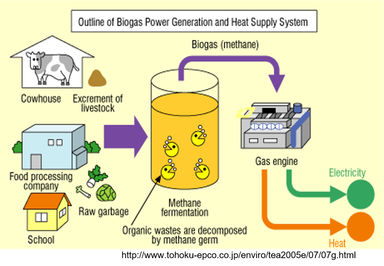
Biomass has some attractions as a fuel over some other renewables since it is not an intermittent resource - it can be supplied on a continuous basis to fuel base load plants.
The overall process involves several stages - growing over two or three years, cutting and converting to wood chip, storage and drying, transport to a power plant for combustion.
Energy from crops has been recognised as a potential key renewables market segment in the UK Government's Renewables Policy.
Biomass heating is now being used in several of the most innovative building projects in the UK - for example the Norman Foster designed greenhouse of the Welsh National Botanic Gardens and the Eden project in Cornwall.
http://eeru.open.ac.uk/greenenergy/biomass.htm
The overall process involves several stages - growing over two or three years, cutting and converting to wood chip, storage and drying, transport to a power plant for combustion.
Energy from crops has been recognised as a potential key renewables market segment in the UK Government's Renewables Policy.
Biomass heating is now being used in several of the most innovative building projects in the UK - for example the Norman Foster designed greenhouse of the Welsh National Botanic Gardens and the Eden project in Cornwall.
http://eeru.open.ac.uk/greenenergy/biomass.htm
|
Geothermal power
Geothermal power is energy generated by heat stored beneath the Earth's surface. Geothermal power supplies 0.416% of the world's energy. Geothermal comes from the Greek words geo, meaning earth, and therme, meaning heat. Prince Piero Ginori Conti tested the first geothermal power plant on 4 July 1904, at the Larderello dry steam field in Italy. The largest group of geothermal power plants in the world is located in The Geysers, a geothermal field in California is the largest geothermal development in the world. It is currently outputting over 750 MW The Geysers consists of 21 separate power plants that utilize steam from more than 350 producing wells. http://en.wikipedia.org/wiki/Geothermal_power |
|
|
Advantages of using renewable energy source
|
Disadvantages of using renewable energy source
The principal disadvantage of many renewable sources is aesthetic. This is simply because those renewable energies are so “dilute” that very large or numerous installations are needed to collect the energy. This is particularly true of solar and wind energy. |
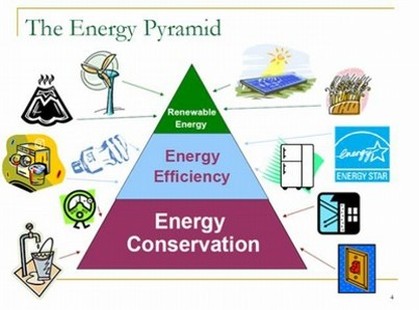
Energy Conservation
Energy Conservation is important for many reasons; economic, environmental and social. It makes economic sense because energy is a commodity which we cannot afford to waste. Although fuel costs have fallen, we still spend around £50 billion a year on fuel in the UK, of which 20%, the government has calculated, could be saved cost-effectively by investing in energy conservation. This would yield savings of over £10 billion a year, money which would boost the economy when spent on other goods and services.
Saving energy makes environmental sense too, because it is universally recognised that we are changing our climate in ways we cannot predict, by altering the composition of the earth's atmosphere as a result of our burning fossil fuels for heat and electricity. The more efficiently we can use energy, the less we need of it to maintain our lifestyle, and the less carbon dioxide will be released into the atmosphere.
http://www.ukace.org/encons.htm
http://www.nwcommunityenergy.org/biogeo/efficiency
http://www.ukace.org/encons.htm
Energy Conservation is important for many reasons; economic, environmental and social. It makes economic sense because energy is a commodity which we cannot afford to waste. Although fuel costs have fallen, we still spend around £50 billion a year on fuel in the UK, of which 20%, the government has calculated, could be saved cost-effectively by investing in energy conservation. This would yield savings of over £10 billion a year, money which would boost the economy when spent on other goods and services.
Saving energy makes environmental sense too, because it is universally recognised that we are changing our climate in ways we cannot predict, by altering the composition of the earth's atmosphere as a result of our burning fossil fuels for heat and electricity. The more efficiently we can use energy, the less we need of it to maintain our lifestyle, and the less carbon dioxide will be released into the atmosphere.
http://www.ukace.org/encons.htm
http://www.nwcommunityenergy.org/biogeo/efficiency
http://www.ukace.org/encons.htm
|
Green building is the practice of increasing the efficiency of buildings and their use of energy, water, and materials, and reducing building impacts on human health and the environment, through better siting, design, construction, operation, maintenance, and removal — the complete building life cycle.
A similar concept is natural building, which is usually on a smaller scale and tends to focus on the use of natural materials that are available locally. Other commonly used terms include sustainable design and green architecture; however, while good design is essential to green building, the actual operation, maintenance, and ultimate disposal or deconstruction of the building also have very significant effects on buildings' overall environmental impact. The related concepts of sustainable development and sustainability are integral to green building. Effective green building can lead to 1) reduced operating costs by increasing productivity and using less energy and water, 2) improved public and occupant health due to improved indoor air quality, and 3) reduced environmental impacts by, for example, lessening storm water runoff and the heat island effect. Practitioners of green building often seek to achieve not only ecological but aesthetic harmony between a structure and its surrounding natural and built environment. The appearance and style of sustainable homes and buildings can be nearly indistinguishable from their less sustainable counterparts. http://en.wikipedia.org/wiki/Green_building http://www.greenbuildingblocks.com http://www.aiabalt.com/0_committees/0_DesignAwards/0_des_awards06/winners06.htm |
|
Green Building Systems
"Green" is a term we have become increasingly familiar with over the years. The idea of "green" has taken many forms, all sharing the ultimate goal of preserving and protecting our environment now and for future generations. Today, it is an advancing principle in construction with qualifying buildings even being certified as green by meeting specified criteria. But, what is a "green building"? How does a green building become LEED certified? And, finally, what makes masonry an exceptional green building material? http://www.masoncontractors.org/aboutmasonry/greenbuildingsystem/index.php |
|
World Trade Center, considered New York City's first "green" office tower by gaining gold status in the U.S. Green Building Council's LEED program.
|
The Leadership in Energy and Environmental Design (LEED) Green Building Rating System, developed by the U.S. Green Building Council, provides a suite of standards for environmentally sustainable construction. Since its inception in 1998, LEED has grown to encompass over 14,000 projects in 50 US States and 30 countries covering 1.062 billion square feet of development area. The hallmark of LEED is that it is an open and transparent process where the technical criteria proposed by the LEED committees are publicly reviewed for approval by the more than 10,000 membership organizations that currently constitute the USGBC. http://en.wikipedia.org/wiki/Leadership_in_Energy_and_Environmental_Design |
|
Energy Conservation Energy use in houses accounts for 30% of all carbon dioxide (CO2) emissions in the UK. By increasing the amount of CO2 in the atmosphere, we are causing changes to the Earth's climate - resulting in rising sea levels, and more frequent instances of flooding, storms and drought. As three-quarters of domestic energy use is for heating, the self-builder has an ideal opportunity to minimise their carbon emissions by maximising the efficiency of their new home - which will of course also lead to lower fuel bills. It is possible to reduce your impact still further by using renewable energy sources (which do not contribute to climate change) such as solar power or wood fuel to meet your remaining energy needs. |

The main considerations are:
insulate well
ensure the building is well draught-proofed
provide adequate ventilation without heat loss
insulate well
ensure the building is well draught-proofed
provide adequate ventilation without heat loss
Spending a little extra on insulation when building a home will lead to big fuels savings over time. Good-quality detailing around doors and windows will minimise draughts and heat loss. Argon-filled double-glazing with a 'low-e' coating is the most efficient, and timber frames have a much lower environmental impact than uPVC or aluminium.
In our mild climate, it is usually most appropriate to have some form of passive ventilation, with warm air rising through the building, and replacement fresh air coming ideally through a 'buffer' space, such as a south-facing conservatory.
Under floor heating gives a comfortable, even heat and is also very efficient, running at about 35°C, rather than the 75°C of conventional radiators.
A low-energy house can obtain over half its heating needs by ‘passive solar’ design methods. These make the best use of available sunlight, by careful orientation of windows and doors. CAT’s Environmental Building fact sheet describes the principles of efficient, low-impact building design, while The Energy Saving House gives lots of advice on saving both energy and money.
http://www.cat.org.uk/index.tmpl?refer=index&init=1
In our mild climate, it is usually most appropriate to have some form of passive ventilation, with warm air rising through the building, and replacement fresh air coming ideally through a 'buffer' space, such as a south-facing conservatory.
Under floor heating gives a comfortable, even heat and is also very efficient, running at about 35°C, rather than the 75°C of conventional radiators.
A low-energy house can obtain over half its heating needs by ‘passive solar’ design methods. These make the best use of available sunlight, by careful orientation of windows and doors. CAT’s Environmental Building fact sheet describes the principles of efficient, low-impact building design, while The Energy Saving House gives lots of advice on saving both energy and money.
http://www.cat.org.uk/index.tmpl?refer=index&init=1
Future energy development, providing for the world's future energy needs, currently faces great challenges. These include an increasing world population, demands for higher standards of living, a need for less pollution. a need to avert global warming, and a possible end to fossil fuels. Without energy, the world's entire industrialized infrastructure would collapse; agriculture, transportation, waste collection, information technology, communications and much of the prerequisites that a developed nation takes for granted.
http://en.wikipedia.org/wiki/Future_energy_development
The environmental consequences of energy production have led many nations in the world to impose stricter guidelines on the production and consumption of energy. Further, the search for new sources of energy and more efficient means of employing energy has accelerated. The development of a viable nuclear fusion reactor is often cited as a possible solution to our energy problems. Presently, nuclear-energy plants use nuclear fission, which requires scarce and expensive fuels and produces potentially dangerous wastes. The fuel problem has been partly helped by the development of breeder reactors, which produce more nuclear fuel than they consume, but the long-term hopes for nuclear energy rest on the development of controlled sources using nuclear fusion rather than fission. The basic fuels for fusion are extremely plentiful (e.g., hydrogen, from water) and the end products are relatively safe. The basic problem, which is expected to take decades to solve, is in containing the fuels at the extremely high temperatures necessary to initiate and sustain nuclear fusion.
http://www.infoplease.com/ce6/sci/A0857983.html
http://en.wikipedia.org/wiki/Future_energy_development
The environmental consequences of energy production have led many nations in the world to impose stricter guidelines on the production and consumption of energy. Further, the search for new sources of energy and more efficient means of employing energy has accelerated. The development of a viable nuclear fusion reactor is often cited as a possible solution to our energy problems. Presently, nuclear-energy plants use nuclear fission, which requires scarce and expensive fuels and produces potentially dangerous wastes. The fuel problem has been partly helped by the development of breeder reactors, which produce more nuclear fuel than they consume, but the long-term hopes for nuclear energy rest on the development of controlled sources using nuclear fusion rather than fission. The basic fuels for fusion are extremely plentiful (e.g., hydrogen, from water) and the end products are relatively safe. The basic problem, which is expected to take decades to solve, is in containing the fuels at the extremely high temperatures necessary to initiate and sustain nuclear fusion.
http://www.infoplease.com/ce6/sci/A0857983.html
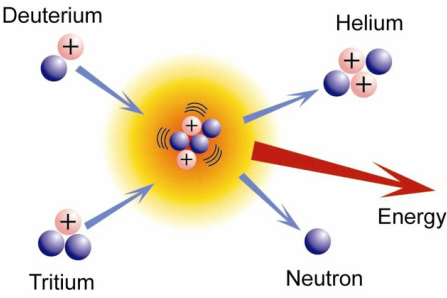
Nuclear Fusion
In Nuclear Fusion the nuclei of atoms fuse together, causing much more energy being released than in Nuclear Fission. This is the process which powers the Sun. Here the Deuterium and Tritium atoms (these are the isotopes of Hydrogen:- these have extra neutrons in the nucleus than normal) fuse together to form He. Energy is released due to a difference in mass between He atoms compared with the sum of the Hydrogen atoms.
http://www.lancs.ac.uk/ug/hussainw/nuclear_fusion.htm
|
Biofuels: Another direction of research and experimentation is in the search for alternatives to gasoline. Possibilities include methanol, which can be produced from wood, coal, or natural gas; ethanol, an alcohol produced from grain, sugarcane, and other agriculture plants and currently used in some types of U.S. motor fuel (e.g., gasohol and E85, a mixture of 85% ethanol and 15% gasoline); compressed natural gas, which is much less polluting than gasoline and is currently used by a 1.5 million vehicles around the world; and electricity, which if ever practicable would be cheaper and less polluting, especially if derived from solar energy, rather than gasoline.
http://www.infoplease.com/ce6/sci/A0857983.html E10, sometimes called gasohol, is a fuel mixture of 10% ethanol and 90% gasoline that can be used in the internal combustion engines of most modern automobiles. According the Philippine Department of Energy E10 is not harmful to cars' fuel systems. On October 27, 2006, though, the Federal Aviation Administration published their Special Airworthiness Information Bulletin - Automobile gasoline containing alcohol (Ethanol or Methanol) is not allowed to be used in aircraft. Although Gasohol 95 (E10) has been introduced to Thailand to replace Premium Gasoline 95 from 1 January 2007, the interim government installed after the coup in September 2006 reversed the decision and has now ruled out the removal of Premium Gasoline from the Thai market in the near term although currently there is talk of subsidizing gasohol. http://en.wikipedia.org/wiki/E10_fuel |
Ethanol, also known as ethyl alcohol, drinking alcohol or grain alcohol, is a flammable, colorless, slightly toxic chemical compound, and is best known as the alcohol found in alcoholic beverages. In common usage, it is often referred to simply as alcohol..
Ethanol is produced both as a petrochemical, through the hydration of ethylene, and biologically, by fermenting sugars with yeast. Which process is more economical is dependent upon the prevailing prices of petroleum and of grain feed stocks.
http://en.wikipedia.org/wiki/Ethanol#Production
Ethanol is produced both as a petrochemical, through the hydration of ethylene, and biologically, by fermenting sugars with yeast. Which process is more economical is dependent upon the prevailing prices of petroleum and of grain feed stocks.
http://en.wikipedia.org/wiki/Ethanol#Production
|
Rudolph Diesel:
Biofuel pioneer |
What are biofuels?
Biofuels are any kind of fuel made from living things, or from the waste they produce. This is a very long and diverse list, including: wood, wood chippings and straw pellets or liquids made from wood biogas (methane) from animals' excrement ethanol, diesel or other liquid fuels made from processing plant material or waste oil. In recent years, the term "biofuel" has come to mean the last category - ethanol and diesel, made from crops including corn, sugarcane and rapeseed. Bio-ethanol, an alcohol, is usually mixed with petrol, while biodiesel is either used on its own or in a mixture. Pioneers such as Henry Ford and Rudolph Diesel designed cars and engines to run on biofuels. Before World War II, the UK and Germany both sold biofuels mixed with petrol or diesel made from crude oil; the availability of cheap oil later ensured market dominance. Ethanol for fuel is made through fermentation, the same process which produces it in wine and beer. Biodiesel is made through a variety of chemical processes. There is interest in trying biobutanol, another alcohol, in aviation fuel. |
Are biofuels climate-friendly?
In principle, biofuels are a way of reducing greenhouse gas emissions compared to conventional transport fuels.
Burning the fuels releases carbon dioxide; but growing the plants absorbs a comparable amount of the gas from the atmosphere.
However, energy is used in farming and processing the crops, and this can make biofuels as polluting as petroleum-based fuels, depending on what is grown and how it is treated. A recent UK government publication declared that biofuels reduced emissions "by 50-60% compared to fossil fuels".
What are the downsides?
From the environmental point of the view, the big issue is biodiversity. With much of the western world's farmland already consisting of identikit fields of monocultured crops, the fear is that a major adoption of biofuels will reduce habitat for animals and wild plants still further. Asian countries may be tempted to replace rainforest with more palm oil plantations, critics say. If increased proportions of food crops such as corn or soy are used for fuel, that may push prices up, affecting food supplies for less prosperous citizens.
http://news.bbc.co.uk/2/hi/science/nature/6294133.stm
In principle, biofuels are a way of reducing greenhouse gas emissions compared to conventional transport fuels.
Burning the fuels releases carbon dioxide; but growing the plants absorbs a comparable amount of the gas from the atmosphere.
However, energy is used in farming and processing the crops, and this can make biofuels as polluting as petroleum-based fuels, depending on what is grown and how it is treated. A recent UK government publication declared that biofuels reduced emissions "by 50-60% compared to fossil fuels".
What are the downsides?
From the environmental point of the view, the big issue is biodiversity. With much of the western world's farmland already consisting of identikit fields of monocultured crops, the fear is that a major adoption of biofuels will reduce habitat for animals and wild plants still further. Asian countries may be tempted to replace rainforest with more palm oil plantations, critics say. If increased proportions of food crops such as corn or soy are used for fuel, that may push prices up, affecting food supplies for less prosperous citizens.
http://news.bbc.co.uk/2/hi/science/nature/6294133.stm
Biofuel (also called agrofuel) can be broadly defined as solid, liquid, or gas fuel consisting of, or derived from biomass. The definition used here is narrower: biofuel is defined as liquid or gas transportation fuel derived from biomass. Biomass can also be used directly for heating or power: this is commonly called biomass fuel:. Biofuel is considered an important means of reducing greenhouse gas emissions and increasing energy security by providing a viable alternative to fossil fuels.
Biofuels are used globally: biofuel industries are expanding in Europe, Asia and the Americas. The most common use for biofuels is in automotive transport (for example E10 fuel). Biofuel can be produced from any carbon source that can be replenished rapidly e.g. plants. Many different plants and plant-derived materials are used for biofuel manufacture.
Biodiesel is the most common biofuel in Europe. It is produced from oils or fats using transesterification and is a liquid similar in composition to mineral diesel. Its chemical name is fatty acid methyl (or ethyl) ester (FAME). Oils are mixed with sodium hydroxide and methanol (or ethanol) and the chemical reaction produces biodiesel (FAME) and glycerol. 1 part glycerol is produced for every 10 parts biodiesel.
Biodiesel can be used in any diesel engine when mixed with mineral diesel. In some countries manufacturers cover their diesel engines under warranty for 100% biodiesel use, although Volkswagen Germany, for example, asks drivers to make a telephone check with the VW environmental services department before switching to 100% biodiesel. Many people have run their vehicles on biodiesel without problems. However, the majority of vehicle manufacturers limit their recommendations to 15% biodiesel blended with mineral diesel. In many European countries, a 5% biodiesel blend is widely used and is available at thousands of gas stations.
In the USA, more than 80% of commercial trucks and city buses run on diesel. Therefore "the nascent U.S. market for biodiesel is growing at a staggering rate—from 25 million gallons per year in 2004 to 78 million gallons by the beginning of 2005. By the end of 2006 biodiesel production was estimated to increase fourfold to more than 1 billion gallons," energy expert Will Thurmond writes in an article for the July-August 2007 issue of THE FUTURIST magazine.
http://en.wikipedia.org/wiki/Biofuel
Biofuels are used globally: biofuel industries are expanding in Europe, Asia and the Americas. The most common use for biofuels is in automotive transport (for example E10 fuel). Biofuel can be produced from any carbon source that can be replenished rapidly e.g. plants. Many different plants and plant-derived materials are used for biofuel manufacture.
Biodiesel is the most common biofuel in Europe. It is produced from oils or fats using transesterification and is a liquid similar in composition to mineral diesel. Its chemical name is fatty acid methyl (or ethyl) ester (FAME). Oils are mixed with sodium hydroxide and methanol (or ethanol) and the chemical reaction produces biodiesel (FAME) and glycerol. 1 part glycerol is produced for every 10 parts biodiesel.
Biodiesel can be used in any diesel engine when mixed with mineral diesel. In some countries manufacturers cover their diesel engines under warranty for 100% biodiesel use, although Volkswagen Germany, for example, asks drivers to make a telephone check with the VW environmental services department before switching to 100% biodiesel. Many people have run their vehicles on biodiesel without problems. However, the majority of vehicle manufacturers limit their recommendations to 15% biodiesel blended with mineral diesel. In many European countries, a 5% biodiesel blend is widely used and is available at thousands of gas stations.
In the USA, more than 80% of commercial trucks and city buses run on diesel. Therefore "the nascent U.S. market for biodiesel is growing at a staggering rate—from 25 million gallons per year in 2004 to 78 million gallons by the beginning of 2005. By the end of 2006 biodiesel production was estimated to increase fourfold to more than 1 billion gallons," energy expert Will Thurmond writes in an article for the July-August 2007 issue of THE FUTURIST magazine.
http://en.wikipedia.org/wiki/Biofuel
